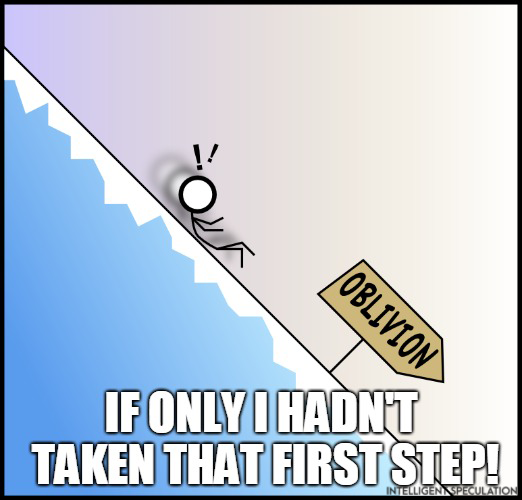Slippery Slope
A type of formal fallacy where a small first event is suggested to lead to another more significant event, which then leads to an even more significant event, and so on, until some ultimate, extreme event is reached. The connections between each significant event are likely related, but the probability of everything unfolding exactly as presented becomes statistically more and more insignificant. That is, the total probability of the sequence of events diminishes after each significant event where it eventually reaches a minimum at the final, extreme event.
Logical Form
Person 1 claims A.
Person 2 rebuts by saying that if we allow A to happen, it will automatically lead to B, then C, then D, and ultimately to Z (where Z is an extreme).
Therefore, A cannot be allowed to happen.
Examples
The following abbreviations are used in the examples below:
PN = The Nth premise for N = 1,2,3,…. (e.g., P1 is the first premise, P2 is the second premise, etc.)
C = Conclusion
1)
P1: If I lend Jon money, then he will most certainly tell his friend Alex about it.
P2: Next, Alex will be asking me for money.
P3: Regardless if I give Alex money or not, he will then go on to tell his friends that I lent Jon money.
P4: Once Alex's friends know, they will go on to tell all of their friends and, eventually, the entire neighborhood will be asking me for money.
P5: The problem will get so bad that I will have to lock myself in my house as people will constantly be harassing me for money.
C: Ergo, I shouldn't lend Jon a single penny.
Explanation: This scenario is incredibly unlikely to unfold to this extreme if I were to lend Jon some money. Yes, a few more people may find out about it if the amount of money is large, but the probability of the chain of events going to the extreme of needing to board myself in my house is very small. That said, if I had just won the lottery, this argument would be stronger than if I were to lend someone $20.
2)
P1: Banning certain guns will eventually lead the Government to ban ALL guns.
C: Therefore, we shouldn't enact laws that ban access to any guns.
Explanation: Just because society chooses to ban one type of gun doesn't automatically imply that this will then lead to the banning of ALL guns. Society decides where to draw the line on which firearms civilians are legally allowed to own.
3)
P1: If we allow homosexuals to marry one another, this will ultimately lead to people being allowed to marry animals, objects, etc.
C: Therefore, homosexuals in our society should not be represented legally when it comes to marriage.
Explanation: Allowing homosexual marriage doesn't automatically imply that society will allow individuals to legally marry (i.e., a marriage that is represented by the state) animals, objects, etc. at some point in the future or ever. To date, this has yet to happen.
4)
P1: Allowing individuals to identify as any gender of their choosing will eventually lead to people wanting to identify as objects, animals, etc.
C: Thus, we shouldn't allow an individual to identify as a gender that is different from their sex*.
Explanation: This argument is almost identical to the flawed arguments made against allowing same-sex marriage, except that we're dealing with gender rights instead of gay rights. Taking the first steps as a society to allow individuals to identify as a gender outside of their sex on a national level legally doesn't mean that this will eventually lead to people being allowed to identify as a superhero, car, etc.
*Note, sex is a biological definition for male or female, while gender is predominantly a societal construct [1].
Conclusion
If you find yourself confronted with this fallacy in everyday discourse, it is important to remember that it renders the argument bad and should be rejected. What is more, if you find yourself using this fallacy within one of your own arguments, as an individual who ascribes to the ethos of Critical Thinking, you must replace it with a good argument.

